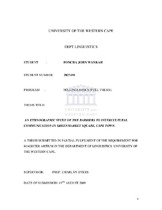| dc.description.abstract | Intercultural communication (ICC) is one of the most relevant fields for investigation in post-colonial Africa and post-apartheid South Africa, given the movements between people from African countries and the wide range of attractions, both economic and social, that South Africa holds for people from other African countries. This study reports on intercultural communication in post-democratic South Africa in an era marked by what Appadurai (1990) calls 'flows'. Greenmarket Square in the heart of Cape Town, well known as a hub for informal traders, local people and tourists, was chosen as the site for this study, because of the rich cultural diversity of the role-players. The principal aim of this research is to examine how people from different cultural backgrounds in this particular space of Greenmarket Square communicate with one another, and where the'intercultural fault-lines' (Olahan, 2000) occur, keeping in mind how ICC could be improved in such a space. My position as a trader in the market placed me in an ideal 'insider' position to do the research. The theory of spatiality (Vigouroux, 2005; Blommaert et al. 2005) was used to show how the space of Greenmarket Square affected intercultural communication. Discourse analysis was also applied to the data to show how the various roleplayers were socially constructed by others. Saville-Troike's (1989) ethnography of communicative events was also used to bring out other barriers that were not identified by spatiality and discourse analysis. Aspects like scene, key, message form and content, the observed rules for interaction and where these rules were broken and to what effect as well as the norms for interpretation were considered during the analysis of this qualitative data. The analysis showed that spatiality, social constructions of 'the other' and other factors like nonverbal communication and differences between communicative styles in high and low context cultures (LCC/HCC), had a major impact on intercultural communication at Greenmarket Square, frequently leading to complete breakdowns in communication. Many of the traders interviewed acknowledged that they needed to improve their competence in intercultural communication. The study concludes with a number of recommendations on how people can become more 'interculturally competent' (Katan, 2004) in a globalized world. | en_US |

